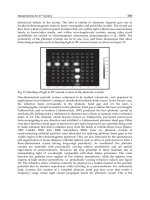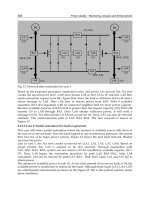Behaviour of Electromagnetic Waves in Different Media and Structures Part 16 docx
Bạn đang xem bản rút gọn của tài liệu. Xem và tải ngay bản đầy đủ của tài liệu tại đây (163.85 KB, 4 trang )
Behaviour of Electromagnetic Waves in Different Media and Structures
438
5. Conclusion
In this chapter, beamforming of antenna arrays focused in NFZ or IFZ is studied and the
new principles of this process are revealed with a purpose to increase the 3-dimensional
gain performance of antenna arrays at a wide range of angles and to improve the quality
level of this technique for expanding applicability of the focused antenna.
The antenna arrays of linear and polygonal structure with different location and types of
array elements have been considered in this paper, so all tasks of study of FAA radiation
pattern synthesis have done in its azimuth plane or in polar coordinates.
Expressions of spatial shifts between elements and phase center of arrays where spatial
shifts by distance and spatial shifts by angular coordinate are obtained as two separate
parts of one equation without any approximation (Fresnel or Fraunhofer) are introduced.
These equations had been obtained first time and they can be useful for FAA with
separate phase steering by distance and by angular coordinate synthesis, it also helps to
reduce the level of computational operations to calculate required phase distribution in
array elements.
Radiation pattern synthesis and focusing properties of focused arrays are considered in this
work, which are based on obtained geometrical models of arrays of different structures.
Location of array phase center, different signal attenuations by propagation from array
elements to observation point, different angles of radiation from array elements to
observation point and array elements radiation patterns dependence on the distance must
be taken to account for precise beamforming of arrays focused in NFZ or IFZ. The principles
of radiation pattern synthesis of arrays focused in NFZ or IFZ and arrays focused in FFZ are
equal. The properties of radiation pattern by distance and angular coordinate are equal too.
The main focusing properties of antenna array are based on principle of inversion of the
Fresnel and the Fraunhofer diffraction fields which is the result of focusing process. The
applicability of arrays is limited by hyperfocal distance and signal attenuation by
propagation. The focal area or a certain segment of distance R∈ [0, R
F
] where radiated
power distribution is uniform can be the result of focusing process.
FAA directivity by distance as angular directivity in focused point to angular directivity in
FFZ ratio is introduced in this chapter.
FAA directivity can be improved by increasing array elements spacing jointly with grating
focal area supressing or by excitation of array elements by wideband signals or by using of
modified APD in array elements and modified AFC of excited wideband signal which are
introduced in this chapter. The spectrum of spatial frequencies concept was used for FAA
directivity improvement.
Investigation results of possible structures of FAA which capable to three-dimensional
spatial division multiplexing in all frequency ranges used by a modern radio-technique are
presented in this work. These results have shown the given FAA applicability in a radio and
short range telecommunication engineering.
The task of obtaining a exact expression for radiation pattern of antenna array without any
approximation still remain unsolved due to lack of solution in the form of a simple or a
special function. Beamforming of planar array using study results achieved in this chapter
have not considered. Methods of FAA directivity improving are considered more
qualitatively than quantitatively. Mutual coupling effect among the array elements and its
real dimensions is not assumed. These facts reveal the possibility of further research.
Focused Arrays Beamforming
439
6. References
Buffi A.; Serra A.; Nepa P.; Manara G. & Luise M. (2009). Near field focused microstrip
arrays for gate access control systems, 2009 IEEE International Antennas and
Propagation Symp. Dig., vol. 47, (June 2009), pp. 1704 - 1707
Chu T. S. (1971). A note on simulating Fraunhofer radiation patterns in the Fresnel region,
Antennas and Propagation, IEEE Transactions on, vol. 19, (Sept. 1971), pp. 691 - 692
Fenn A. J. (2007). Adaptive Antennas and Phased Arrays for Radar and Communications.
Artech House Publishers, ISBN: 978-1-59693-273-9, Boston, USA
Garrett J. E. & Wiltse J. C. (1990). Antenna pattern characteristics of phase-correcting Fresnel
zone plates, 1990 IEEE International Antennas and Propagation Symp. Dig., vol. 28,
(May 1990), pp. 1906 - 1909
Graham W. J. (1983). Analysis and synthesis of axial field patterns of focused apertures,
Antennas and Propagation, IEEE Transactions on, vol. 31, (July 1983), pp. 665 - 668
Hansen R. C. (1964). Microwave Scanning Antennas. vol. 1, Apertures., Ed. Academic Press,
New York, USA
Hansen R. C. (1985). Focal region characteristics of focused array antennas, Antennas and
Propagation, IEEE Transactions on, vol. 33, (December 1985), pp. 1328 - 1337
Hansen R. C. (2009). Phased Array Antennas, 2nd Ed., John Wiley & Sons, ISBN 978-0-470-
40102-6, New Jersey, USA
Herben M. H. A. J. & Hristov H. D. (1999). Some developments in Fresnel zone plate lens
antennas, 1999 IEEE International Antennas and Propagation Symp. Dig., vol. 37, (June
1999), pp. 726 - 729
Hristov H. D.; Feick R.; Grote W. & Fernández P. (2004). Indoor signal focusing by means of
Fresnel zone plate lens attached to building wall, Antennas and Propagation, IEEE
Transactions on, vol. 52, (April 2004), pp. 933 - 940
Hussain M. G. M. & Al-Zayed A.S. (2008). Aperture-sparsity analysis of ultrawideband two-
dimensional focused array, Antennas and Propagation, IEEE Transactions on, vol. 56,
(July 2008), pp. 1908 - 1918
Hussain M. G. M. (2004). Characteristics of ultrawideband electro-magnetic missiles
generated by focused two-dimensional array. Progress In Electromagnetics Research,
PIER 49, pp.143–159
Ishimaru A.; Jaruwatanadilok S. & Kuga Y. (2007). Imaging of a target through random
media using a short-pulse focused beam, Antennas and Propagation, IEEE
Transactions on, vol. 55, (June 2007), pp. 1622 - 1629
Karimkashi Sh. & Kishik A. A. (2008). A New Fresnel Zone Antenna with beam Focused in
the Fresnel Region. U.R.S.I. XXIX General Assembly 7-16 August 2008, Chicago, USA.
Available from:
Karimkashi, Sh. & Kishk, A.A. (2009). Focused Microstrip Array Antenna Using a Dolph-
Chebyshev Near-Field Design, Antennas and Propagation, IEEE Transactions on ,
vol.57, no.12, (December 2009), pp.3813-3820
Korostelev A. A. (1987). Space-time theory of radio system. Radio i Svyaz, Moscow, USSR (in
Russian)
Kremer I. Ya., Kremer A. I. & Petrov V. M. (1984). Space-time signal processing. Radio i Svyaz,
Moscow, USSR (in Russian)
Behaviour of Electromagnetic Waves in Different Media and Structures
440
Laybros S.; Combes P. F. & Mametsa H. J. (2005). The "Very-near-field"region of equiphase
radiating apertures, IEEE Antennas and Propagation Magazine, vol. 47, (August 2005),
pp. 50 - 66
Malyuskin O. & Fusco V. (2009). Near field focusing properties of finite wire array under
sinusoidal pulse excitation, 2009 IEEE International Antennas and Propagation Symp.
Dig., vol. 47, (June 2009), pp. 3380 - 3383
Mazurenko, A.V. & Yakornov, E.A. (2010). Analysis of perspective antenna systems with
controlled 3-dimensional signal space division, Microwave and Telecommunication
Technology (CriMiCo), 2010 20th International Crimean Conference, vol.2, pp.562-563,
13-17 Sept. 2010
Molotkov N. Ya., Lomakina O. V. & Yegorov A. A. (2009). UHF optics and quasioptics.
Publishing of TSTU, ISBN 978-5-8265-0880-0, Tambov, Russia. (in Russian)
Narasimhan M. S. & Philips B. (1987a). Synthesis of near-field patterns of arrays, Antennas
and Propagation, IEEE Transactions on, vol. 35, (February 1987), pp. 212 - 218
Narasimhan M. S. & Philips B. (1987b). Synthesis of near-field patterns of a nonuniformly
spaced array, Antennas and Propagation, IEEE Transactions on, vol. 35, (November
1987), pp. 1189 - 1198
Polk Ch. (1956). Optical fresnel-zone gain of a rectangular aperture, Antennas and
Propagation, IRE Transactions on, vol. 4, (January 1956), pp. 65 - 69
Reid D. R. & Smith G. S. (2009). A comparison of the focusing properties of a Fresnel zone
plate with a doubly-hyperbolic lens for application in a free-space, focused-beam
measurement system, Antennas and Propagation, IEEE Transactions on, vol. 57,
(February 2009), pp. 499 - 507
Rudolph S. M. & Grbic A. (2008). Super-resolution focusing using volumetric, broadband
NRI media, Antennas and Propagation, IEEE Transactions on, vol. 56, (September
2008), pp. 2963 - 2969
Wang G. ; Fang J. & Dong X. (2007). Resolution of near-field microwave target detection and
imaging by using flat LHM lens, Antennas and Propagation, IEEE Transactions on, vol.
55, (December 2007), pp. 3534 - 3541
Wu, T. T. (1985). Electromagnetic missiles, Journal of Applied Physics, vol. 57, pp. 2370-2372.
Xiao Shu, Schoenbach K.H. & Baum C. E. (2008). Time-Domain Focusing Radar for Medical
Imaging. U.R.S.I. XXIX General Assembly 7-16 August 2008, Chicago, USA. Available
from:









